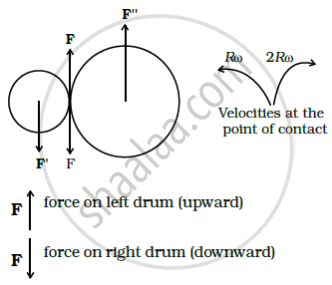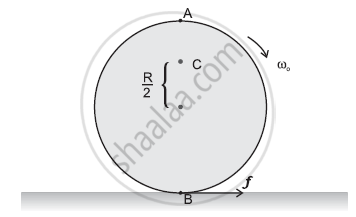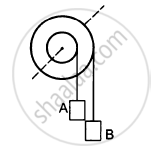Advertisements
Advertisements
Question
Two cylindrical hollow drums of radii R and 2R, and of a common height h, are rotating with angular velocities ω(anti-clockwise) and ω(clockwise), respectively. Their axes, fixed are parallel and in a horizontal plane separated by (3R + δ). They are now brought in contact (δ → 0).
- Show the frictional forces just after contact.
- Identify forces and torques external to the system just after contact.
- What would be the ratio of final angular velocities when friction ceases?
Solution
a. The frictional forces acting between two cylindrical hollow drums are shown in the diagram below.
Force F upward shows the friction force on the left drum.
Force F downward shows the friction force on the right drum.
b. F' = F = F” where F and F” are external forces through support.
⇒ Fnet = 0 ......(one each cylinder)
Net external torque to the system about any axis = F × 3R, anticlockwise

c. Let ω1 and ω2 be the final angular velocities of smaller and bigger drums respectively (anticlockwise and clockwise respectively).
Finally, there will be no friction. When friction ceases at the point of contact, then both drums have an equal linear velocity at that point.
VA = VB
Hence, Rω1 = 2Rω2 ⇒ `ω_1/ω_2` = 2
Important point: Friction force just opposes the relative motion of the point of contact at any instant. So, we should be very careful while indicating the direction of frictional forces.
APPEARS IN
RELATED QUESTIONS
A disc rotating about its axis with angular speed ωois placed lightly (without any translational push) on a perfectly frictionless table. The radius of the disc is R. What are the linear velocities of the points A, B and C on the disc shown in Figure? Will the disc roll in the direction indicated?

A sphere rolls on a horizontal surface. If there any point of the sphere which has a vertical velocity?
A body is in pure rotation. The linear speed \[\nu\] of a particle, the distance r of the particle from the axis and the angular velocity \[\omega\] of the body are related as \[\omega = \frac{\nu}{r}.\] Thus
The following figure shows a small wheel fixed coaxially on a bigger one of double the radius. The system rotates about the common axis. The strings supporting A and B do not slip on the wheels. If x and y be the distance travelled by A and B in the same time interval, then _________ .

A disc of radius 10 cm is rotating about its axis at an angular speed of 20 rad/s. Find the linear speed of a point on the rim.
A wheel rotating at a speed of 600 rpm (revolutions per minute) about its axis is brought to rest by applying a constant torque for 10 seconds. Find the angular deceleration and the angular velocity 5 seconds after the application of the torque.
A wheel of mass 10 kg and radius 20 cm is rotating at an angular speed of 100 rev/min when the motor is turned off. Neglecting the friction at the axle, calculate the force that must be applied tangentially to the wheel to bring it to rest in 10 revolutions.
A boy is standing on a platform which is free to rotate about its axis. The boy holds an open umbrella in his hands. The axis of the umbrella coincides with that of the platform. The moment of inertia of "the platform plus the boy system" is 3⋅0 × 10−3 kg-m2 and that of the umbrella is 2⋅0 × 10−3 kg-m2. The boy starts spinning the umbrella about the axis at an angular speed of 2⋅0 rev/s with respect to himself. Find the angular velocity imparted to the platform.
Suppose the platform of the previous problem is brought to rest with the ball in the hand of the kid standing on the rim. The kid throws the ball horizontally to his friend in a direction tangential to the rim with a speed \[\nu\] as seen by his friend. Find the angular velocity with which the platform will start rotating.
A ball falls on the ground from a height of 2.0 m and rebounds up to a height of 1.5 m. Find the coefficient of restitution.
